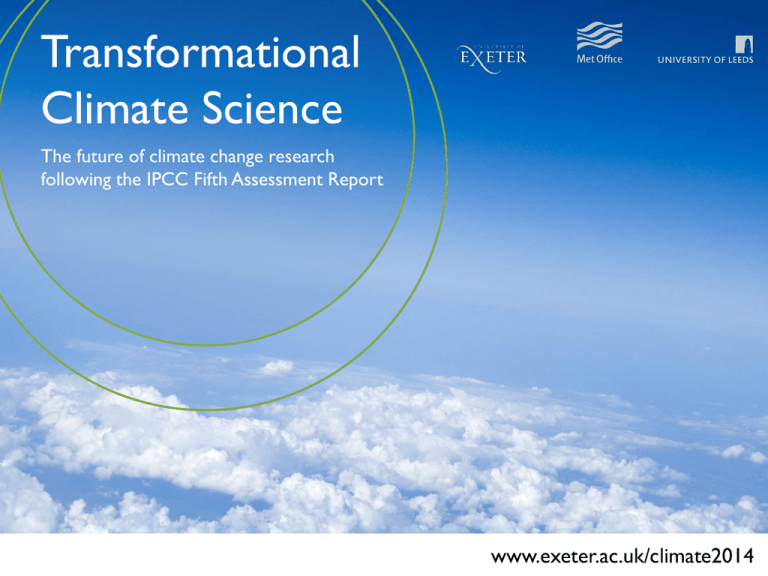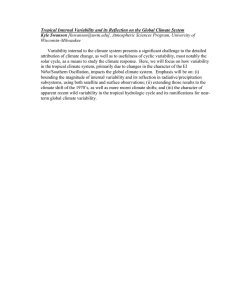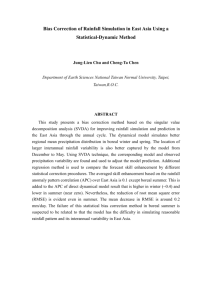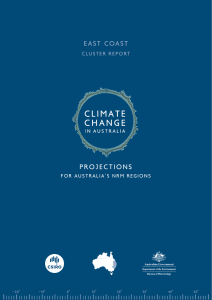Transformational Climate Science www.exeter.ac.uk/climate2014 The future of climate change research
advertisement

Transformational
Climate Science
The future of climate change research
following the IPCC Fifth Assessment Report
www.exeter.ac.uk/climate2014
Working
Group I
The challenge of climate change
#climate2014
The challenge of climate change
Professor Mat Collins
Joint Met Office Chair in Climate Change,
Met Office and University of Exeter
Long Term Climate Change: Projections,
Commitments and Irreversibility
Mat Collins, Reto Knutti, Julie Arblaster, Jean-Louis Dufresne,
Thierry Fichefet, Pierre Friedlingstein, Xuejie Gao, Bill
Gutowski, Tim Johns, Gerhard Krinner, Mxolisi Shongwe,
Claudia Tebaldi, Andrew Weaver, Michael Wehner
© Yann Arthus-Bertrand / Altitude
Global Mean Surface Air Temperature Change
Anomalies w.r.t 1986-2005 average
Global Temperature Assessment
•The transient climate response is
likely in the range of 1.0°C to 2.5°C
(high confidence) and extremely
unlikely greater than 3°C
• The CMIP5 models coincide with
this range
• The RCPs are dominated by
greenhouse gas forcing by the end
of the century
• Associate the 5-95% range of
model simulations (+/- 1.64
standard deviations) with the likely
range (66-100%)
• Only valid for likely (66-100%)
• Only valid for global mean
temperature in long-term
Global Mean Surface Air Temperature Change
5-95% ~ ‘likely’
Anomalies w.r.t 1986-2005 average
likely = 66-100% probability
Global Temperature Assessment
Global surface temperature change for the end of the 21st century is
likely to exceed 1.5°C relative to 1850 to 1900 for all RCP scenarios
except RCP2.6. It is likely to exceed 2°C for RCP6.0 and RCP8.5, and
more likely than not to exceed 2°C for RCP4.5. Warming will continue
beyond 2100 under all RCP scenarios except RCP2.6. Warming will
continue to exhibit interannual-to-decadal variability and will not be
regionally uniform (see Figures SPM.7 and SPM.8). {11.3, 12.3, 12.4,
14.8}
What about regional changes, rainfall, sea-ice etc. etc?
How large is the projected change
compared with internal variability?
RCP8.5
Stippling: changes
are “large” compared
with internal variability
variability,
(greater
than
andtwo
>90%
of modelsdeviations
standard
agree on of
sign of change
internal
variability),
and at least 90% of
models agree on sign
of change
Hatching: changes
are “small”
compared with
internal variability
(less than one
standard deviation of
internal variability
Changes Conditional on Global Mean
Temperature Rise
• High northern latitudes expected to warm most
• Land warms more than ocean surface
• More hot and fewer cold extremes
• Global mean precipitation increases but regional patterns of change not
uniform
• Contrast between wet and dry regions and seasons to increase (with
regional exceptions)
• Tropical atmospheric circulations expected to weaken, subtropics creep
polewards
• Arctic summer sea-ice to melt back – ice free conditions likely by mid
century under RCP8.5
• Permafrost and snow cover to retreat
• Atlantic Meridional Overturning Circulation (AMOC) to weaken but not
collapse
• N. Hemisphere storm track changes – low confidence
Cryosphere
Solid lines – subset of models
Shading – min/max
Dotted – all CMIP5 models
Annex I: Atlas of Global and Regional Climate Projections
Annex I: Atlas of Global and Regional Climate Projections
Rainfall Change in
the Tropical Pacific
• Rainfall change anchored to an equatorial peak in SST warming across the Pacific
• SST change a result of oceanic processes in the west and atmospheric processes in the
east (Xie et al., 2010)
• This change in mean rainfall impacts El Nino teleconnections and increases the
frequency of ‘extreme’ El Nino events (Cai et al., 2014, Power et al., 2013)
http://climexp.knmi.nl/plot_atlas_form.py
#climate2014
Challenges in making Future Projections
• There are some robust features that emerge in climate models, that we
understand and can use to make assessments of very large-scale climate
change (land-sea contrast, polar amplification, thermodynamic rainfall…)
• For some projections we are learning how to ‘calibrate’ sets of models
(e.g. Arctic summer sea-ice)
• We are beginning to understand some aspects of regional climate
variability and change better
• Models are still imperfect, observations are still incomplete and theory is
still under-developed
• We do not yet routinely try and combine information from models,
observations and understanding to make quantitative projections that may
be compared
• The above is really addressing the forced-response, the role of natural
internal variability is still very important on shorter time scales
Further Information
www.climatechange2013.org
© Yann Arthus-Bertrand / Altitude







